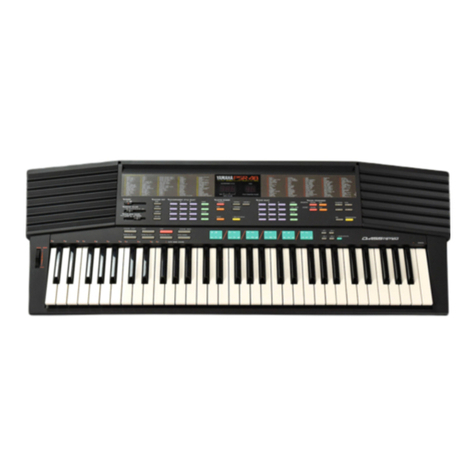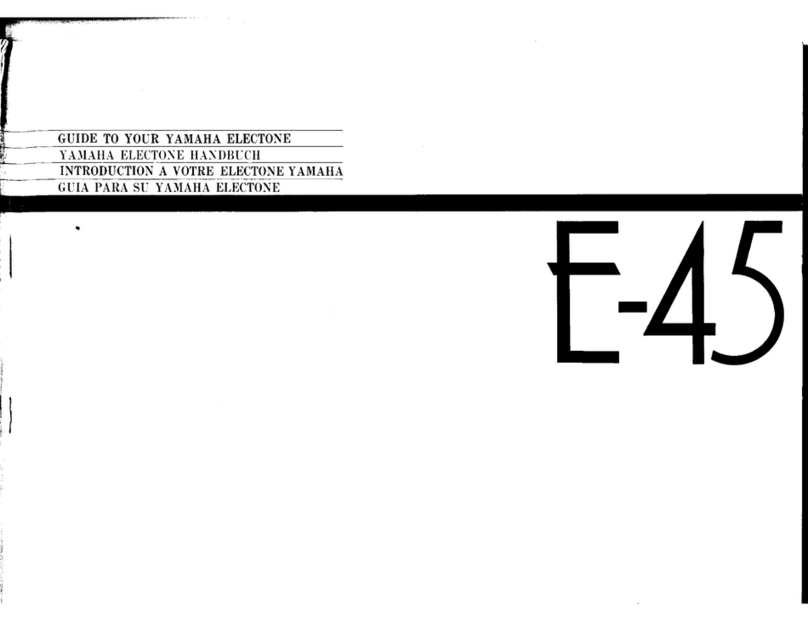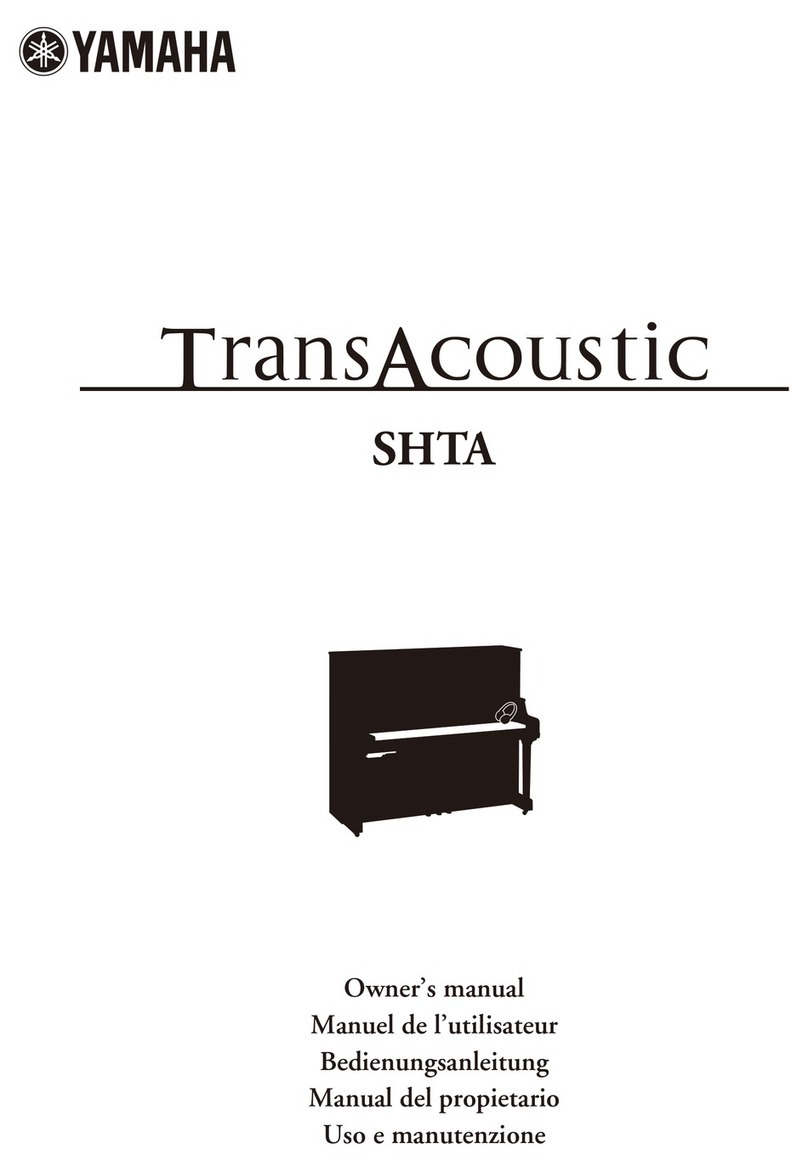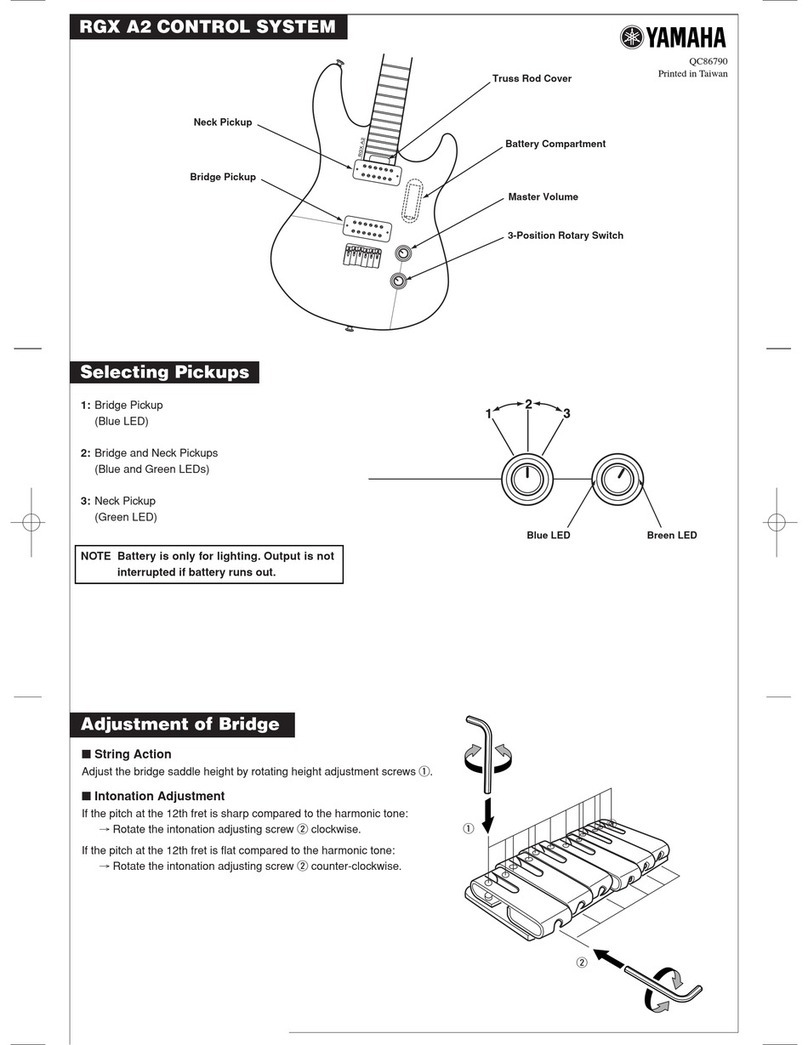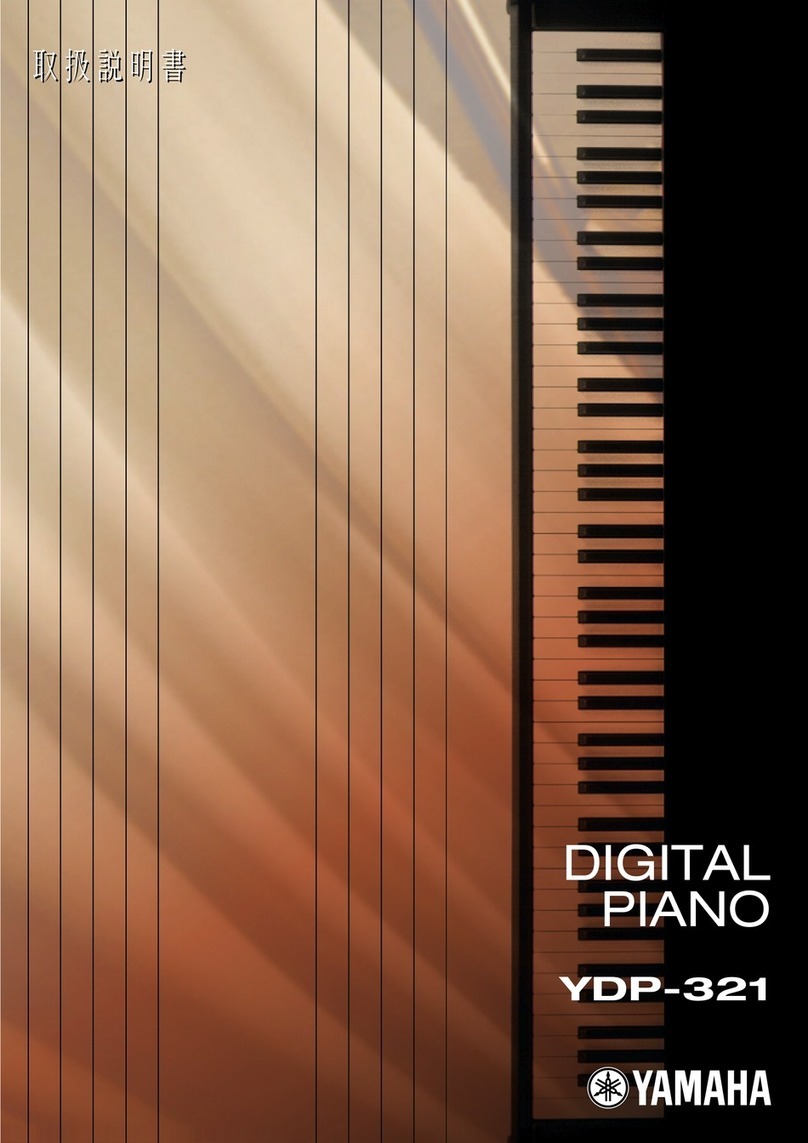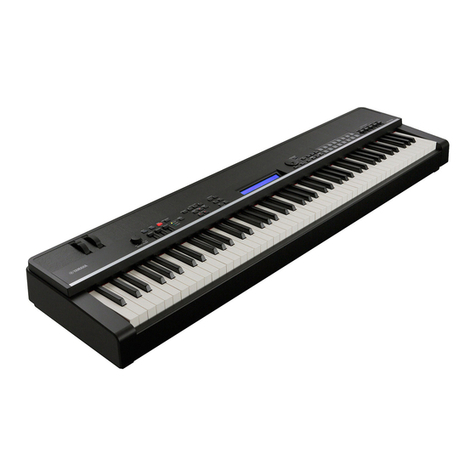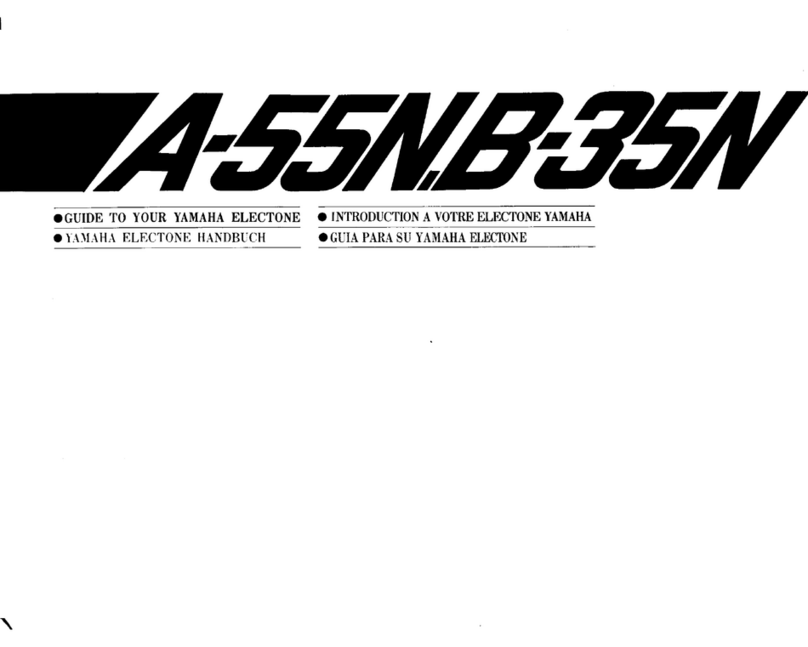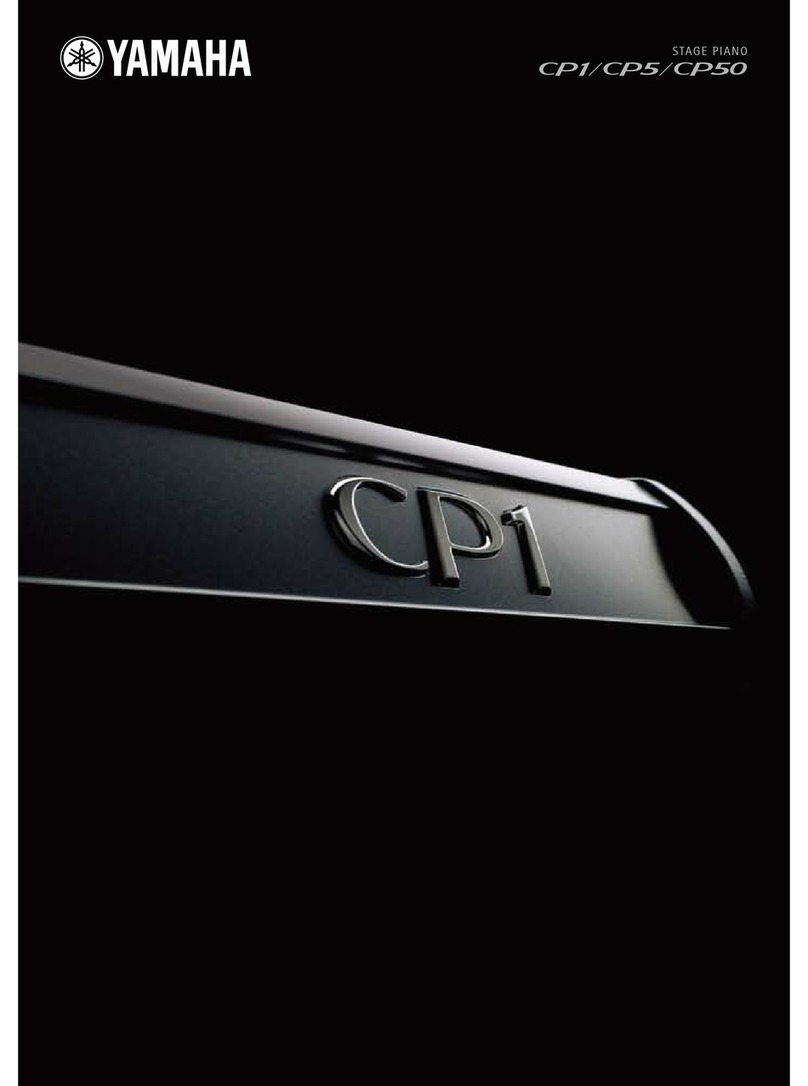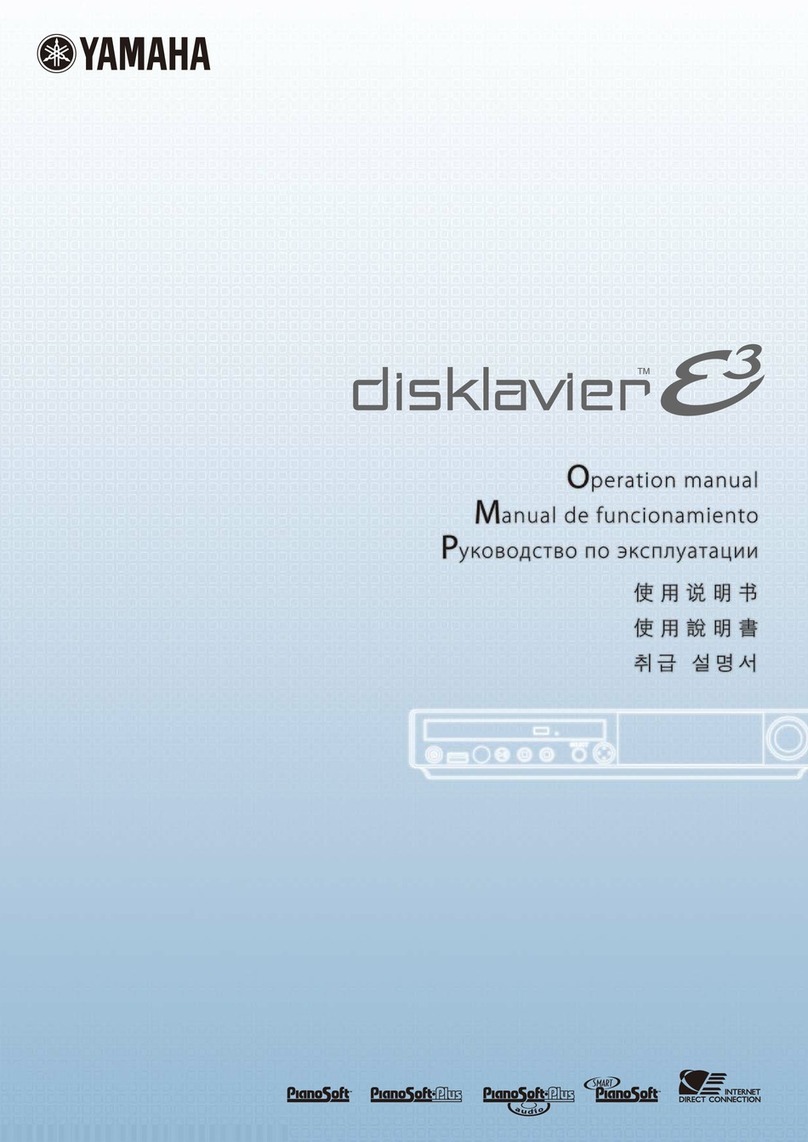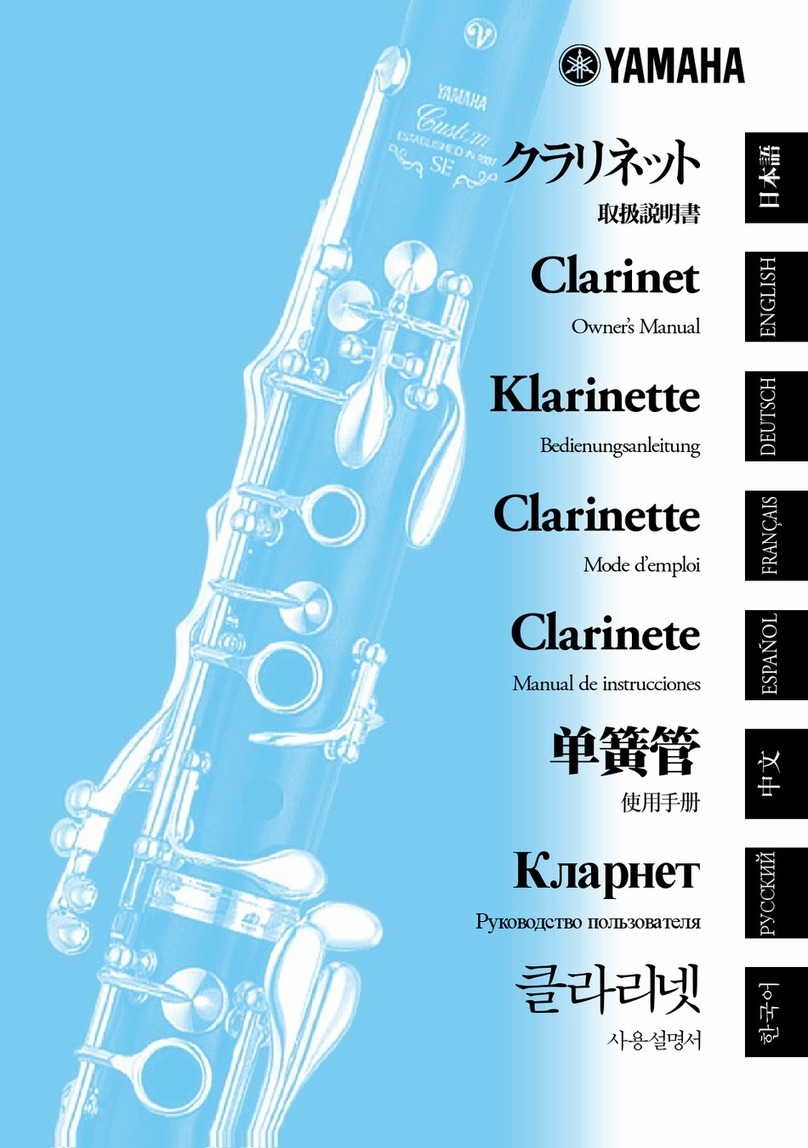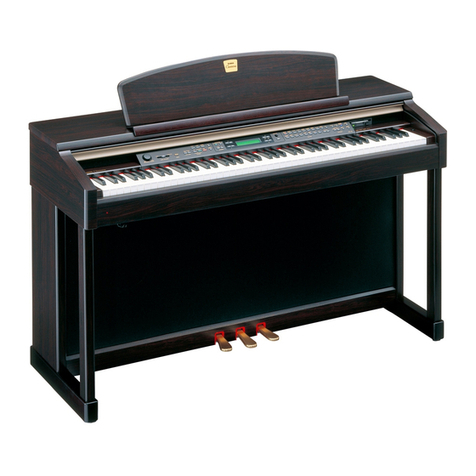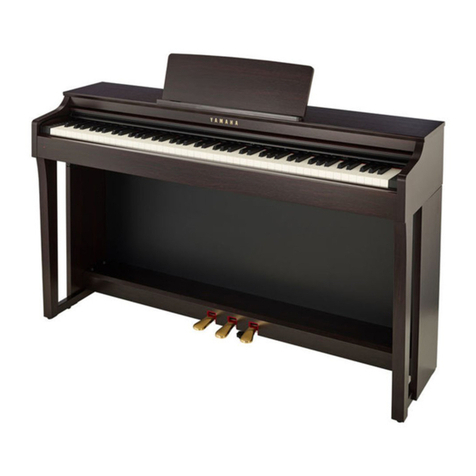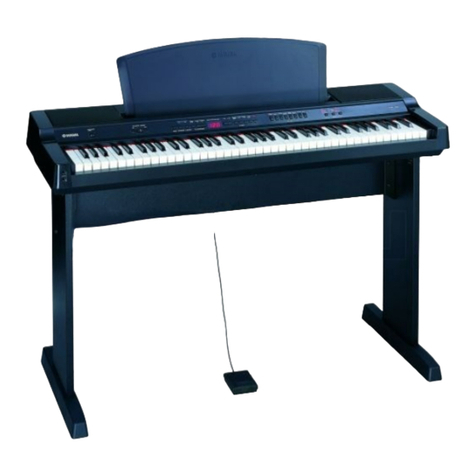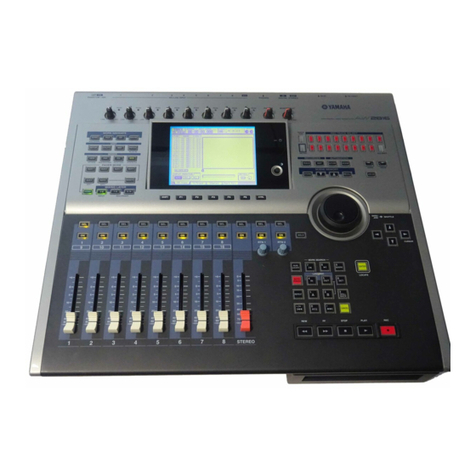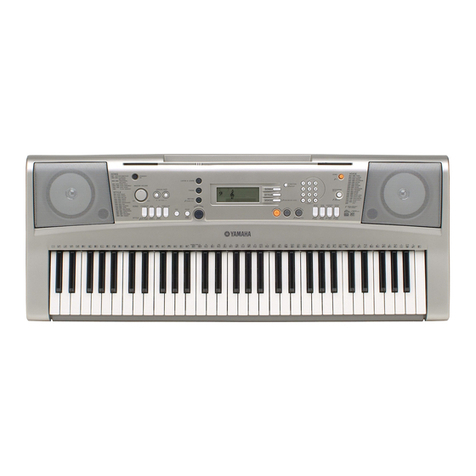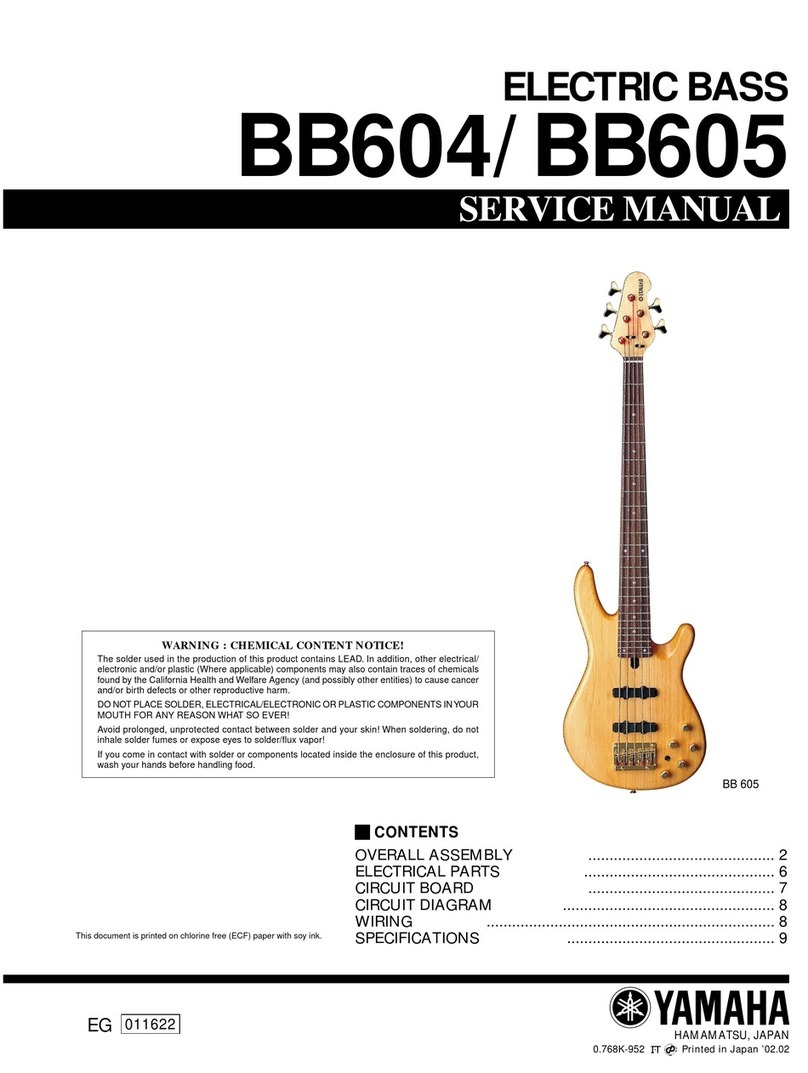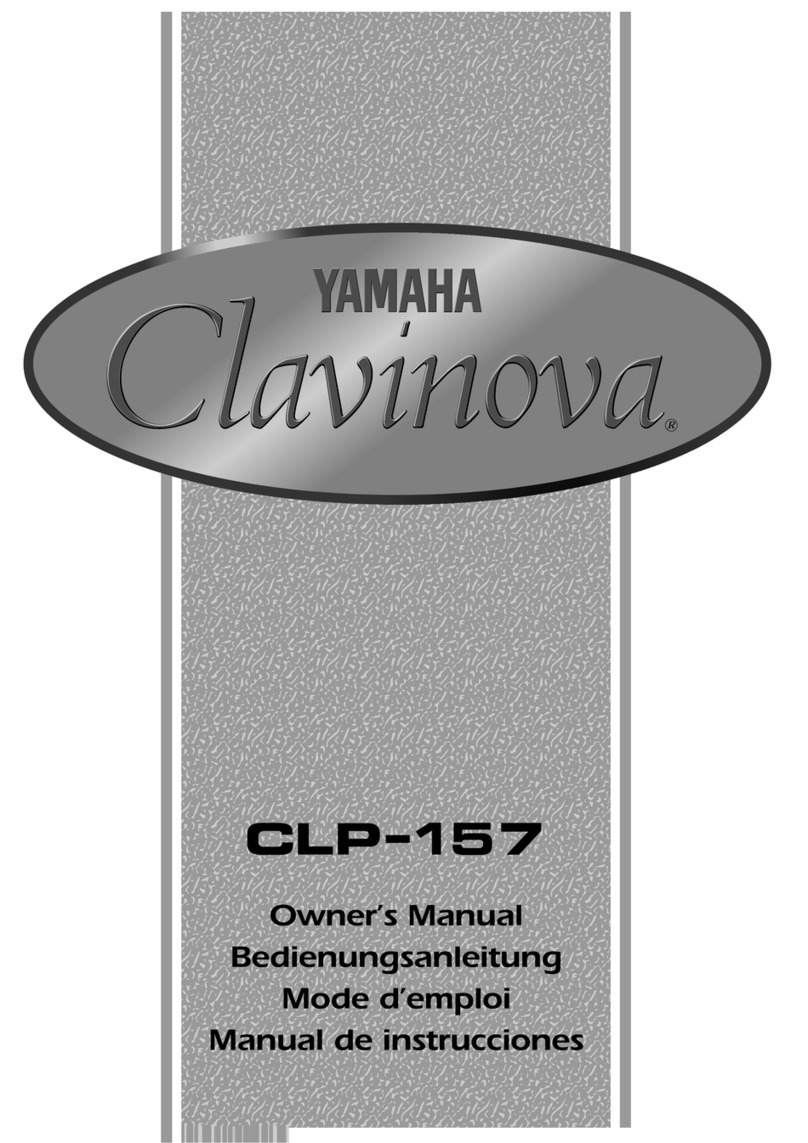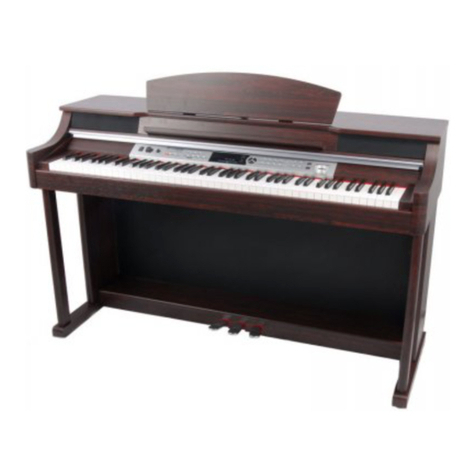
PROPER CONDITIONS
MEAN BETTER SOUND
l
Pianos work best and sound
best when the temperature and
humidity are right. Proper
ventilation is also important.
Generally speaking, a relative
humidity of between 50 and
60 percent is ideal for pianos.
The use of materials such as
wood, felt and cloth in piano
construction means that many
parts are quite delicate. If not
properly cared for, they can be
damaged easily. Therefore we
are unable to assume respon-
sibility for damage resulting
from abuse or harsh treatment.
HOW HUMIDITY
AFFECTS A PIANO
l
Felt, cloth, leather and the pre-
cision wood parts – some of
them machined to tolerances
as fine as 1/100 mm – used in
such critical parts of the piano
as the action are extremely
sensitive to humidity. Too
much humidity will result in
dull hammer action and un-
clear tones, rusting of internal
parts and sticking keys. Be-
fore this happens the piano
should be repaired.
GUTE BEDINGUNGEN
VERBÜRGEN GUTEN
KLANG
l
Bei richtiger Temperatur und
Luftfeuchtigkeit arbeitet Ihr
Instrument am besten und gibt
den schönsten Klang. Wich-
tig ist auch eine hinreichende
Ventilation. Im allgemeinen
ist eine relative Luftfeuch-
tigkeit zwischen 50 und 60%
ideal.
Besonders empfindliche Ma-
terialien wie Filz, Stoff und
Holz werden bei der Herstel-
lung von Flügeln und Pianos
verwandt, und deshalb sind
diese Teile sehr empfindlich.
Bei unsachgemäßer Behand-
lung können schnell Schäden
entstehen, für welche wir kei-
nerlei Haftung übernehmen.
SCHÄDEN DURCH
LUFTFEUCHTIGKEIT
l
An entscheidenden Stel-
len des Instrumentes wer-
den Filz, Leder, Stoff und
feinpräzisierte Holzteile
bis zu einer Toleranz von
1/100 mm verwendet. Sie
sind hochempfindlich gegen
Luftfeuchtigkeit. Zu große
Luftfeuchtigkeit führt zu trä-
ger Hammerbewegung und
unreinen Tönen, Rosten der
Innenteile und Klemmen der
Tasten beim Anschlag. Bevor
es soweit kommt, sollten Sie
Ihr Instrument des öfteren prü-
fen lassen.
DE BONNES
CONDITIONS, POUR
DE MEILLEURS SONS
l
Votre piano fonctionnera à la
perfection et aura une tonalité
optimale si la température et
l’humidité de la pièce sont
contrôlées. En général, une
humidité relative de 50 á
60% est idéale pour un piano.
Fabriquées en bois, en feutre
ou en tissu, la plupart de ses
pièces sont très délicates. Si
elles ne sont pas bien entrete-
nues, elles seront facilement
endommagées. Nous ne
pouvons donc assumer la res-
ponsabilité de détériorations
causée par la négligence.
COMMENT
L’HUMIDITE AFFECTE
LE PIANO
l
Le feutre, le tissu, le cuir et
les pièces de précision en
bois, dont quelques unes sont
fabriquées avec une tolérance
de 1/100 mm sont employées
dans les parties les plus dé-
licates du piano, comme le
contrôle de l’action des mar-
teaux, mais sont très sensibles
à l’humidité. Si le degré d’
humidité est trop élevé, il en
résultera un affaiblissement
de l’action des marteaux,
qui à son tour entraînera la
détérioration de la tonalité, la
rouille des pièces métalliques
et l’affaissement des touches.
Nous vous prions de faire
réparer votre piano avant que
tout cela n’arrive.
CONDICIONES
ADECUADAS
SIGNIFICAN MEJOR
SONIDO
l
Los pianos funcionan y suenan
mejor cuando la temperatura
y la humedad son correctas.
Una apropiada ventilación
también es muy importante.
Por lo general, una humedad
relativa entre 50 y 60 por
ciento es ideal para los pianos.
El empleo de materiales tales
como madera, fieltro y paño
en la construcción del piano
significa que muchas partes
son muy delicadas. Si no se
les ha protegido adecuada-
mente, pueden fácilmente ser
dañadas. Por tal motivo no
podemos asumir responsabili-
dad por el daño resultante del
abuso o el mal trato.
LA HUMEDAD AFECTA
AL PIANO
l
El fieltro, paño, cuero y
las partes precisas de ma-
dera – algunas de ellas
fabricadas con tolerancias
de tanta precisión como
1/100 mm – utilizadas en
partes muy delicadas en el
mecanismo del piano, son
extremadamente sensibles a la
humedad. La excesiva hume-
dad dará como resultado una
deficiente acción del martillo
o tonos poco claros, enmohe-
cimiento en las partes internas
y teclas que se pegan. Antes
de que esto suceda, el piano
debiera ser reparado.
适宜的环境可确保更
好的音色
l
适宜的温度和湿度,良好
的通风环境是钢琴的演
奏性能和声学品质表现
最佳的必要条件。总体
来说,相对湿度保持在
50%-60% 是比较理想的。
钢琴的某些内部构件,如
木、绒、毡等材料的对环
境的变化极为敏感,稍有
不慎就会损坏。对因保养
不善所引起的质量问题,
我们将不承担任何责任。
湿度对钢琴的影响
l
由绒、毡、皮及木材制
成的击弦机构件精密度
很高,允许的误差被限
制在 1/100mm 以内。这
些构件对湿度的变化极
其敏感,湿度过高会导
致击弦机运动迟钝,琴
声沉闷,金属键生锈和
琴键失灵等问题出现。
çÄÑãÖÜÄôàÖ
ìëãéÇàü
éÅÖëèÖóàÇÄûí
ãìóòàâ áÇìä
l
ç‡ËÎÛ˜¯ËÈ Á‚ÛÍ ÔˇÌËÌÓ
ÔÓÎÛ˜‡ÂÚÒ ÔË ÒÓÓÚ‚ÂÚÒÚ‚
Û˛˘ÂÈ ÚÂÏÔ‡ÚÛÂ Ë ‚·
ÊÌÓÒÚË ‚ÓÁ‰Ûı‡. 燉ÎÂʇ˘
‡ ‚ÂÌÚËÎˆË Ì ÏÂÌ ‚‡
Ê̇. Ç Ó·˘ÂÏ ÒÎÛ˜‡Â ÓÔÚËÏ
‡Î¸Ì‡ ÓÚÌÓÒËÚÂθ̇ ‚·
ÊÌÓÒÚ¸ ‰Î ÔˇÌËÌÓ Ì‡ıÓ‰
ËÚÒ ‚ ԉ·ı ÓÚ 50 ‰Ó 60
ÔÓˆÂÌÚÓ‚. èËÏÂÌÂÌË ‚
ÍÓÌÒÚÛ͈ËË ÔˇÌËÌÓ Ú‡
ÍËı χÚ¡ÎÓ‚, Í‡Í ‰Â‚
Ó, ÙÂÚ Ë Ú̸͇, ÓÁ̇˜‡ÂÚ, ˜
ÚÓ ÏÌÓ„Ë ‰ÂÚ‡ÎË ‰Ó‚ÓθÌÓ
˜Û‚ÒÚ‚ËÚÂθÌ˚ Í ‚̯ÌËÏ
ÛÒÎÓ‚ËÏ. èË ÌÂÒÓÓÚ‚ÂÚÒÚ
‚Û˛˘ÂÏ ÛıӉ Ëı ÏÓÊÌÓ ÎÂ
„ÍÓ Ôӂ‰ËÚ¸. èÓʺÚÓÏÛ Ï
˚ ÌÂ ÏÓÊÂÏ ÌÂÒÚË ÓÚ‚ÂÚÒÚ‚
ÂÌÌÓÒÚ¸ Á‡ ÔÓ‚ÂʉÂÌË, ‚˚
Á‚‡ÌÌ˚ ÌÂÔ‡‚ËθÌ˚Ï ËÎË
„Û·˚Ï Ó·‡˘ÂÌËÂÏ Ò ËÌÒÚ
ÛÏÂÌÚÓÏ.
äÄä ÇãÄÜçéëíú
ÇéáÑÖâëíÇìÖí çÄ
èàÄçàçé
l
îÂÚ, Ú̸͇, ÍÓʇ Ë ÏÂÎÍËÂ
‰Â‚ÌÌ˚ ‰ÂÚ‡ÎË – ÔË
˜ÂÏ ÌÂÍÓÚÓ˚ ËÁ ÌËı ËÁ
„ÓÚÓ‚ÎÂÌ˚ Ò ÚÓ˜ÌÓÒÚ¸˛ ‰
Ó 1/100 ÏÏ – ËÒÔÓθÁÛ˛ÚÒ
‚ ÓÚ‚ÂÚÒÚ‚ÂÌÌ˚ı ‰ÂÚ‡Îı
ÏÓÎÓÚÓ˜ÍÓ‚Ó„Ó ÏÂı‡ÌËÁχ
ÔˇÌËÌÓ Ë ‚βÚÒ ˜ÂÁ‚˚
˜‡ÈÌÓ ˜Û‚ÒÚ‚ËÚÂθÌ˚ÏË Í ‚
·ÊÌÓÒÚË. ëÎ˯ÍÓÏ ‚˚ÒÓÍ
‡ ‚·ÊÌÓÒÚ¸ Ô˂‰ÂÚ Í Ì
‡Û¯ÂÌ˲ ‡·ÓÚ˚ ÏÓÎÓÚÓ
˜ÍÓ‚Ó„Ó ÏÂı‡ÌËÁχ Ë ÔË„
ÎÛ¯ÂÌ˲ Á‚ÛÍÓ‚, ÍÓÓÁËË
‚ÌÛÚÂÌÌËı ‰ÂÚ‡ÎÂÈ, ‡ Ú‡
ÍÊ Á‡Ô‡‰‡Ì˲ Í·‚˯. èË
‡ÌËÌÓ ÒΉÛÂÚ Ò‚Ó‚ÂÏÂÌÌÓ
ÓÚÂÏÓÌÚËÓ‚‡Ú¸, ˜ÚÓ·˚
Ì ‰ÓÔÛÒÚËÚ¸ ÔÓ‰Ó·Ì˚ı ̇
Û¯ÂÌËÈ.
ps-11本文071218.indd 5 07.12.18 2:13:33 PM
